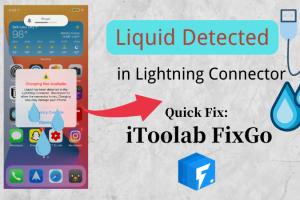5 Simple Steps to Resolve "Liquid Detected in Lightning Connector" Issue

-
Quick Links:
- Introduction
- Understanding the Issue
- Step 1: Disconnect Your Device
- Step 2: Check the Lightning Connector
- Step 3: Dry the Connector
- Step 4: Test the Device
- Step 5: Seek Professional Help
- Case Studies
- Expert Insights
- FAQs
Introduction
Experiencing the "Liquid Detected in Lightning Connector" warning can be frustrating, particularly if you rely on your Apple devices for daily tasks. This warning appears when moisture is detected in the Lightning port, prompting concerns about potential damage. Fortunately, this issue can often be resolved with a few simple steps. This comprehensive guide will provide you with five easy steps to fix the problem, as well as insights into prevention and the importance of understanding the technology behind your devices.
Understanding the Issue
The Lightning connector is a proprietary connector used by Apple devices like iPhones and iPads. When moisture or liquid comes into contact with the connector, the device may trigger a warning to prevent further damage. Understanding how this sensor works can help you navigate the solution process more effectively.
How the Sensor Works
Apple devices are equipped with moisture sensors that detect liquid presence in the Lightning port. The sensor is designed to protect the internal components from damage by disabling charging and data transfer until the moisture is resolved.
Step 1: Disconnect Your Device
As soon as you see the "Liquid Detected in Lightning Connector" warning, the first step is to disconnect your device from any accessories immediately. This prevents further damage and allows the device to enter a safe mode.
Step 2: Check the Lightning Connector
After disconnecting your device, inspect the Lightning connector for any visible signs of liquid or debris. Sometimes, dirt or lint can interfere with the connection and trigger the warning. Use a flashlight to see better and look for:
- Moisture droplets
- Dust or lint accumulation
- Corrosion signs
Step 3: Dry the Connector
Once you've inspected the connector, it's time to dry it out. Here are some effective methods:
- Air Dry: Let the device sit in a dry area for a few hours to allow natural evaporation.
- Use Silica Gel: Place your device in a container with silica gel packets, which can help absorb moisture.
- Compressed Air: Use a can of compressed air to gently blow out any moisture in the connector. Be careful not to insert the nozzle too deeply.
Step 4: Test the Device
After allowing time for drying, reconnect your device to the charger and check if the warning persists. If it does, repeat the drying process. If the warning goes away, congratulations! Your device is back in action.
Step 5: Seek Professional Help
If the warning continues to appear after multiple attempts to dry the connector, it may be time to seek professional help. Apple’s support team or a certified repair shop can offer diagnostics and repair services to address any underlying issues.
Case Studies
Let’s explore some real-world scenarios of individuals who faced the "Liquid Detected in Lightning Connector" issue and how they resolved it:
Case Study 1: John’s iPhone 12
John noticed the warning after a rainstorm. He immediately disconnected his phone, checked for moisture, and left it to air dry overnight. The next morning, the warning was gone, and his phone worked perfectly.
Case Study 2: Sarah’s iPad Pro
Sarah accidentally spilled water on her iPad. After following the same steps as John, she used silica gel to speed up the drying process. After waiting for a few hours, her iPad was functional again.
Expert Insights
We spoke with a tech expert, who provided valuable insights into minimizing the risk of liquid damage:
“Avoid using your device in wet environments. Consider investing in a waterproof case if you frequently use your devices outdoors.” - Tech Expert
FAQs
1. What does "Liquid Detected in Lightning Connector" mean?
This warning indicates that moisture has been detected in your device’s Lightning port, triggering protective measures.
2. Can I use my device while the warning is displayed?
It is advisable to avoid using your device until the moisture issue is resolved to prevent damage.
3. How long does it take for the connector to dry?
It can take anywhere from a few hours to a day, depending on the moisture level and drying method utilized.
4. Is it safe to use a hairdryer to dry the connector?
No, using a hairdryer can cause heat damage. Stick to air drying or silica gel methods.
5. What should I do if my device doesn’t charge after drying?
If the warning persists, consider seeking professional repair services as there may be deeper issues.
6. Can I prevent liquid damage?
Using a waterproof case and avoiding wet environments can help prevent liquid damage to your device.
7. Is it possible for the warning to be a false alarm?
Yes, sometimes dust or debris can trigger the sensor without any actual moisture being present.
8. What tools do I need to check the Lightning connector?
A flashlight, compressed air, and potentially a soft brush can help you inspect and clean the connector.
9. How can I clean my Lightning connector safely?
Use a soft brush or a toothpick to gently remove any debris without damaging the connector.
10. What are the risks of ignoring the warning?
Ignoring the warning can lead to permanent damage to the device’s internal components.
Random Reads
- How to repair cracks in wood floors
- Mastering internal citations
- How to repair windows 7
- How to repair water damaged iphone
- How to see under a door
- How to sell a product
- How to install french drain system
- How to set up usb game controllers windows 8
- How to use chemical drain cleaner
- How to hard reset macbook pro